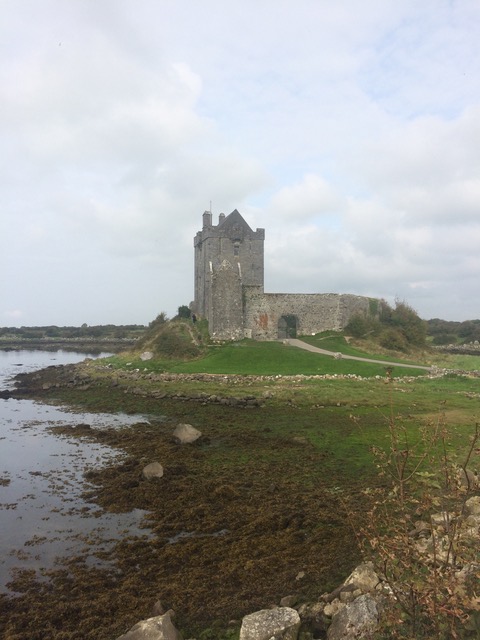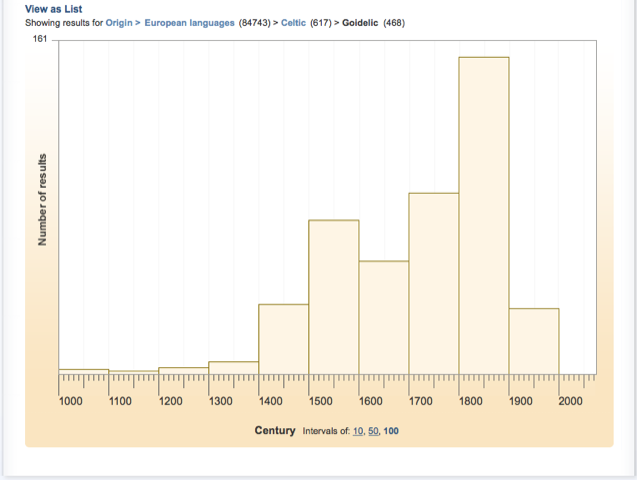Friday, March 13th, 2020...6:01 pm
Gaelic Loanwords in Early Modern English
Mae McDonald

Dunquaire Castle near Kinvarra in the County of Galway. Image: (c) Tammy McDonald.
With Ireland and Scotland close to parts of England, loanwords from Gaelic were bound to enter the English language in some way. Loanwords began to really pop up around the 14th century and slowly increased until the 20th century where there was a large drop. Focusing on the 16th century, there is a commonality in the types of loanwords. A large chunk of the most used words that came from Gaelic in this time period were words that described landscape features or had to do with agriculture. I didn’t go into a specific dialect of Gaelic, in order to keep it open to both Irish and Scottish Gaelic. Most of the words I’m planning on looking at are under the Goidelic branch of Celtic. Because of this, there are only a few words that have about a medium frequency and must have been universal throughout the Gaelic dialects.

OED timeline of influence for Celtic. Image: OED Online.
The loanword with the highest frequency that is in current use is pet. Pet comes from the Scottish Gaelic word peata which meant tame animal. The OED definition of pet as a noun is “a lamb or (later occasionally) other domestic animals reared by hand” (OED s.v. pet, sense A1a). The first use of this term is recorded in Accounts of the (Lord High) Treasurer of Scotland in 1539. The typical meaning that we know of now, “an animal … kept for pleasure or companionship” (OED s.v. pet, sense A1b), wasn’t used until 1710. It seems likely that the word developed the way it did because in other places of the world people may have reared animals other than sheep until it became a term used for domestic animals that are adopted into a family, as they are today. This would mean that there may not have been a word in English for an animal companion until this term was borrowed from Gaelic.
Bog is also still in current use and has a frequency band of five which means it occurs “between 1 and 10 times per million words in typical Modern English usage” (OED). A bog is a landscape feature that originates from the Gaelic word bogach. The definition supplied by the OED is, “a piece of wet spongy ground, consisting chiefly of decayed or decaying moss and other vegetable matter, too soft to bear the weight of any heavy body upon its surface” (OED s.v. bog, sense 1). It is unclear exactly when this word was borrowed into English but the date is assumed to be some before 1513. This was the first recorded use of the word in The Poems of William Dunbar. I don’t believe I’ve ever seen a bog but I am aware what it is and have heard this term in many British novels.
The next word is in less common use than the previous two with a frequency band of three, meaning the word occurs “between 0.01 and 0.1 times per million words” (OED). Strath originates from the Scottish Gaelic word srath which, in the early 1500s, was a kind of river valley. The <th> digraph is now pronounced /h/ in Gaelic but was pronounced as an interdental fricative until the 13th century. The definition of strath is “a broad, flat river valley bounded by hills or high ground” (OED s.v. strath, sense 1). It is most commonly used before or after the name of a river, for example, the Strath of Menteth which comes from the first record of the word in 1508.
Other less commonly used loanwords include kyle and ballyboe. Kyle comes from the Gaelic word caol (pronounced /kə:l/). It’s mostly used in Scotland to describe “a narrow channel between two islands, or an island and the mainland” (OED s.v. kyle). This word has only the one definition in the OED and was first used in written Gaelic by Donald Monro in 1549. The second word, ballyboe, is defined as “a measure of land in Ireland” (OED, s.v. ballyboe). It comes from the Irish Gaelic word baile bó and is considered a historical word since it no longer exists in Modern English. Ballyboe is in the frequency band two which means that it occurs “fewer than 0.01 times per million words” (OED). It was first recorded in 1550 in Parliamentary Papers of Ireland and last recorded in 2001 in M. Elliott’s Catholics of Ulster. The latter seems to be a history of Catholicism in Ulster; the last time it was used before that was in 1842.
Piotr Stalmaszcyk noted the same thing that I had, that is “most of the loanwords remain firmly associated with the land of their origin, its terrain and the life of its people” (80). The latter point refers to agriculture, at least as I see it. The most frequently used loanword, pet, was used in agriculture, mostly with sheep. Scotland and Ireland are well known for their sheep filled countryside. Ireland especially produces a lot of wool based products. The other two borrowed terms are landscape features. I have heard bog before but never strath that is used to talk about a river bed. Ireland and Scotland both have beautiful landscapes and although these two terms don’t describe some of the most common features, like cliffs, they’re both features that can be pictured in these countries. I think that there are a lot of loanwords from Gaelic that describe landscape features because there seem to be lots of landscape features in Ireland or Scotland that don’t appear in England. I suspect that most of these words are ones that English didn’t have a name for so when they saw them in other places, perhaps in travelling to Ireland or Scotland, they took the name they heard these features referred to as by the people that lived there. If you ever go to Ireland or Scotland, I would suggest looking up some of these words to see if people think you’re crazy or not. Just for fun!
Works Cited
[OED.] Oxford English Dictionary Online. Oxford University Press, 2019. www.oed.com. Accessed 5 February 2019.Stalmaszczyk, Piotr. “Celtic elements in English vocabulary – a critical reassessment.” Studia Anglica Posnaniensia XXXII. 1997.